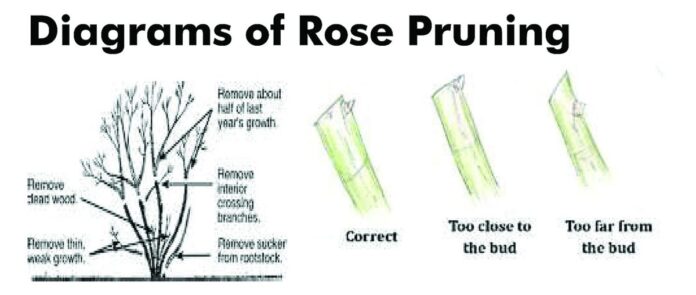BY LORI MURRAY
Our Valley weather doesn’t get cold enough for roses to need winter protection, and the plants don’t really go dormant. As a result, many gardeners don’t want to cut back their roses.
Also, many of us find pruning rather intimidating and worry that we’ll kill our plants.
Just remember that cutting off old wood regularly produces new wood and that the energy that would have gone into keeping the old wood alive goes into producing new wood and flowers.
Saving the plant’s energy will reward you with a multitude of blooms. Finally, reassure yourself that it is very hard to kill a rose with bad pruning.
Most mistakes will grow out quickly, and cutting a plant back is better than letting it grow rampant.
Here are some points to keep in mind:
1. You are pruning to open the center of the bush to light and air circulation which helps the plant avoid disease and encourages new growth.
2. Make your cuts at a 45 degree angle, about ¼ inch above a stout bud that is facing out. The slant should be away from the bud so water and rain will not wash toward it.(see diagram)
3. Use clean, sanitized, and sharp bypass pruners to avoid spreading disease. (use Lysol wipes)
4. Remove all branches that look dry, or black. Remove branches thinner that a pencil. Remove branches that are growing horizontally and interfering with circulation.
5. Identify and remove sucker branches growing from the rootstock. Make the cut flush with the bud union found at the base of the plant. If a stub is left, it may die back into the union and allow disease to enter.
If cane borers are a problem, seal the cut with white glue such as Elmers.
Most rose pruning in the Valley is done around Valentine’s day (easy to remember). Watch for when the leaf buds begin to swell on your plant. Here is some information by rose variety:
Ever-Blooming Roses and Floribunda: These bloom best on the current season’s growth. Prune hard (1/3 to 2/3 the plant’s height) in the spring. Leave 3 – 5 healthy canes of various lengths from 18 – 24 inches evenly spaced around the plant.
Hybrid Teas and Grandiflora: These also bloom on new wood and should be pruned in early spring.
Remove the center stems and any branches crossing inwards. Then reduce the length of the remaining stems to 18 – 24 inches.
Ramblers: Prune to shape and keep size in check. Ramblers bloom only once and can be pruned to 2 – 3 inches right after flowering.
Shrub Roses: This group is repeat bloomers, blooming on mature, but not old, woody stems. Leave them unpruned to increase vigor for the first two years and then use the one-third method: each year remove one-third of the oldest canes.
Climbers: Climbers may repeat bloom. Prune after flowering to shape and keep their size in check.
Bourbons and Portlands: There will repeat bloom, blooming on both old and new wood. A hard pruning and shaping can be done after the first flowering.
Alba, Centifolia, Damasks, Gallica, and Mosses: This group blooms only once, producing flowers on old wood, and doesn’t require much pruning at all. Prune after flowering to shape the plant.
Miniature Roses: Prune only to shape. Cut back to an outward facing bud after bloomi ng.
Sources:
American Rose Society – All About Pruning
Aggie-horticulture.tamu.edu/archives/parsons/publications/roses/care.html
gardening.about.com/od/rose1/a/RosePruning htm
ehow.com/how_4897938_prune-rose-bushes-winter.htm
Bonnie Garcia, How to Prune Roses
Audrey Paterson, Pruning Established Roses




